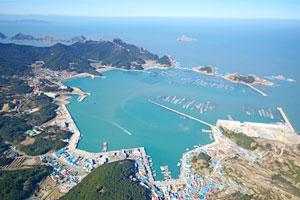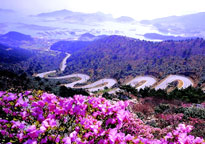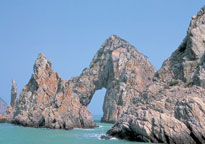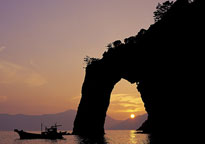
Heuksan-myeon, Shinan-gun
The most beautiful island, Heuksan-myeon
Mountains and seas that have dark-bluish colors than plain green, all shapes of rocks soaring high from the deep sea, and rocky cliffs shaped by wrestling with waves in one corner of the land for eternal hours, all these are harmonized with the sea and reminiscent of a scenery painting.

Winding Road at Sangra Hill

Nammoon Rock, Hongdo Island

Great Stone Gate,
Yeongsando Island
It is said that people started to live in this island after Jangbogo established Cheonghaejin in Wando and it was named as Heuksando because of the dark blue or black color of the sea. It is relatively a big island with the area of 19.7㎢ and the coastline of 41.8km.
The majority of the area is mountainous and thus, there is no rice-paddy and the island depends heavily on fisheries and tourism. Yeri port of Heuksando is an advanced base of nearby fisheries in Dongjina sea and southwest sea and many Yeong fishing boats take off and arrive. Large-sized tourism development has been actively conducted and Gageodo (Soheuksando) in the far southwestern area is developed as an advanced base for fisheries.
Centered around Daeheuksando, the nearby Youngsando, Damuldo, Daedundo and Hongdo are blessed touristic sites and each island has unique cultural heritages and belonged to Dadohae National Marine Park. Heuksando has a 24km-long
road running around the entire island and along this road, most of the beautiful nature and cultural heritages that Heuksando has can be seen. If a boat tour is selected, the route would be from Yeri port to Yeolmok cave → Skates village → Beom village → Chilseong cave → dolphin rock → monk rock → candle stick rock → man's genital rock → turtle rock for 2 and a half hour trip.
Heuksando is far away from the land and in the old days, it was an island that many people were exiled to. Sir Yak-Jeon Jeong, scholar-official in the late Chosun era, the second brother of Dasan Yak-Yong Jeong, was exiled here for 15 years and by collecting 155 species of fish and seafood in the nearby sea, Sir Jeong recorded the names, shapes, distributions, status, etc. of them and left the book called Jasaneobo. Scholar and general of the righteous army, Myeonam Ik-Hyeon Choi left his hand-writing of "Gibong Gangsan Hongmu Ilwol" on the palm rock in Cheonchon-ri, Heuksan-myeon. Later, in front of Jijangam, his disciples established a monument to pass down Myeonam's noble spirit of patriotism and will to train junior scholars to descendants. Choryeong tree that used to be designated as national treasure is believed to call ghost if its branch is served to altar of Buddha. Nearby, there are evergreen forests and Seonghwangdang and so many cultural relics such as colony of Jiseok graves in Jinri, three-layer stone pagoda, stone lantern, and Sachon private academy.
For islands near Daeheuksando, there are Hongdo, the entire island was designated as Natural Treasure No. 170, Yongsando with breathtaking Youngsan 8 sceneries and Seokju door rock, Damuldo with candlestick rock and modernization model fishery village, Sang.Jung.Hataedos popular for year-round sea fishing, and Gageodo (Soheuksando) in the tip of southwestern area of the west sea that is famous for sea fishing and where chickens from China are heard.
Specialties: skate, abalone, scallop, anchovy, rockfish, sea urchin, seaweed, kelp, tot, etc.
The majority of the area is mountainous and thus, there is no rice-paddy and the island depends heavily on fisheries and tourism. Yeri port of Heuksando is an advanced base of nearby fisheries in Dongjina sea and southwest sea and many Yeong fishing boats take off and arrive. Large-sized tourism development has been actively conducted and Gageodo (Soheuksando) in the far southwestern area is developed as an advanced base for fisheries.
Centered around Daeheuksando, the nearby Youngsando, Damuldo, Daedundo and Hongdo are blessed touristic sites and each island has unique cultural heritages and belonged to Dadohae National Marine Park. Heuksando has a 24km-long
road running around the entire island and along this road, most of the beautiful nature and cultural heritages that Heuksando has can be seen. If a boat tour is selected, the route would be from Yeri port to Yeolmok cave → Skates village → Beom village → Chilseong cave → dolphin rock → monk rock → candle stick rock → man's genital rock → turtle rock for 2 and a half hour trip.
Heuksando is far away from the land and in the old days, it was an island that many people were exiled to. Sir Yak-Jeon Jeong, scholar-official in the late Chosun era, the second brother of Dasan Yak-Yong Jeong, was exiled here for 15 years and by collecting 155 species of fish and seafood in the nearby sea, Sir Jeong recorded the names, shapes, distributions, status, etc. of them and left the book called Jasaneobo. Scholar and general of the righteous army, Myeonam Ik-Hyeon Choi left his hand-writing of "Gibong Gangsan Hongmu Ilwol" on the palm rock in Cheonchon-ri, Heuksan-myeon. Later, in front of Jijangam, his disciples established a monument to pass down Myeonam's noble spirit of patriotism and will to train junior scholars to descendants. Choryeong tree that used to be designated as national treasure is believed to call ghost if its branch is served to altar of Buddha. Nearby, there are evergreen forests and Seonghwangdang and so many cultural relics such as colony of Jiseok graves in Jinri, three-layer stone pagoda, stone lantern, and Sachon private academy.
For islands near Daeheuksando, there are Hongdo, the entire island was designated as Natural Treasure No. 170, Yongsando with breathtaking Youngsan 8 sceneries and Seokju door rock, Damuldo with candlestick rock and modernization model fishery village, Sang.Jung.Hataedos popular for year-round sea fishing, and Gageodo (Soheuksando) in the tip of southwestern area of the west sea that is famous for sea fishing and where chickens from China are heard.
Specialties: skate, abalone, scallop, anchovy, rockfish, sea urchin, seaweed, kelp, tot, etc.

